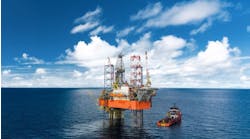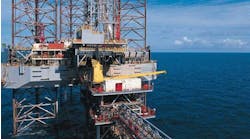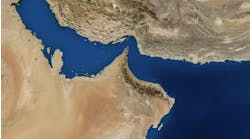By Judy Maksoud
International Editor
Shallow-water jackup targets deep gas on the shelf
Rowan Companies is known for the enormous "Gorilla-class" jackups, built for deepwater drilling in the world's harshest environments. When the first "Tarzan-class" jackup, the Scooter Yeargain, is finished in mid-2004, Rowan will own one of the highest-specification shallow-water jackups on the market.
"There's really nothing out there to compare this rig to because the rig is specifically designed to drill deep, high-temperature, high-pressure (HT/HP) wells," said Eddie Robertson, project engineer and member of the design team. Unlike other shallow-water jackups, the Scooter Yeargain is outfitted with a kit that allows it to reach a level of performance comparable to Rowan's Gorilla IV, an ultra-harsh environment rig.
Why a new rig design?
Recently acquired 3D and 4D seismic data show very deep gas plays in the shallow water areas in the Gulf of Mexico. The 15,000-20,000 ft drilling depth capability of other shallow-water jackups leaves these deep zones beyond the reach of the drill bit. Rowan's new rig is designed to drill 25,000-30,000 ft to reach these newly identified potential pay zones.
The US Minerals Management Service (MMS) believes new discoveries of deep gas on the continental shelf offer the best short-term opportunity, the large reserve additions, and high flow rates necessary to offset declining gas production, which has been falling since 1997. The last three GoM lease sales continued royalty suspension intended to help offset the high cost and high risk associated with drilling deep gas wells on the shelf. The MMS is now considering applying the same royalty relief in <650 ft water depth leases that predate the 2001-2002 sales. The MMS estimates the potential of undiscovered resources for deep gas at 5 tcf to 20 tcf.
So the Tarzan-class jackup "opens up a new market," Robertson explained. And according to Rowan's numbers, that market could be sizable. Of the 50,577 wells that have been drilled in the GoM, only 2,569 reached or exceeded a total vertical depth of 15,000 ft. Other rigs on the market with comparable drilling capabilities are much bigger rigs that demand much higher dayrates, not to mention the added cost related to the logistics of moving those rigs, Robertson said.
Specifications
The Scooter Yeargain will be rated for 250-ft water depth and will be able to handle 7 million lb of combined variable load, in comparison to the 7.69 million lb capability of the much bigger Gorilla IV.
Instead of a standard trio of mud pumps, the Scooter Year-gain is equipped with a mud system that delivers 7,500 psi via three, 3,000 horsepower (hp) pumps. These new mud pumps, designed by LeTour-neau Ellis Williams Company (Lewco), have the highest specifications on the market. This provision is essential for drilling the HT/HP wells that are being targeted on the continental shelf, Robertson said.
Pumping capabilities set this rig apart from others in its water-depth class. The mud pumps can pump more than 3,100 gallons per minute (gpm), in comparison to Rowan's first series of Gorilla rigs, which pump about 1,400 gpm at 4,400 psi. The objective is to deliver the greatest volume possible in the shallow hole sections and to deliver higher pressure, up to 1,800 gpm at 7,500 psi, when the well reaches greater depth.
The opposed jacking system will also expand the rig's capabilities, allowing a greater variable load and a higher load when jacking. Total weight of the fully outfitted rig will be 21,265 kips.
Newbuild vs. upgrade
The new rig will cost less than $100 million to build. The extensive capabilities of the new design would have required upgrade costs of about $55 million to an existing jackup and would have resulted in a rig that fell short of the Scooter Yeargain's capabilities. An upgrade would not have allowed the loads that Rowan wanted to achieve or the jacking capability required under those higher loads. Furthermore, installing the necessary drilling equipment to reach the targeted depth would have been next to impossible on a converted jackup.
In-house construction
Rowan is manufacturing a lot of the components for the Tarzan-class rig in house. Lewco, which is a Rowan company, will build the 3,000 hp drawworks and the 49.5-in. rotary table in addition to the mud pumps. OEM, an electrical company recently purchased by Rowan, will build the SCR systems and many of the motors.
By manufacturing in house, Rowan will exercise more control over cost, design, and quality assurance than it could employ if components were outsourced, Robertson said.
Design challenges
The biggest hurdle for design engineers is the size of the footprint. The Scooter Yeargain jackup has a total deck area of 26,009 sq ft, which is a limiting factor for designers who are trying to fit in equipment that will allow for capabilities comparable to those on a Gorilla-class jackup. The Gorilla-class rigs have about 42,200 sq ft of deck area. "It is a challenge to make everything fit and to provide enough room for everything to work," Robertson said. Despite that challenge, engineers are optimistic that the result will exceed expectations.





